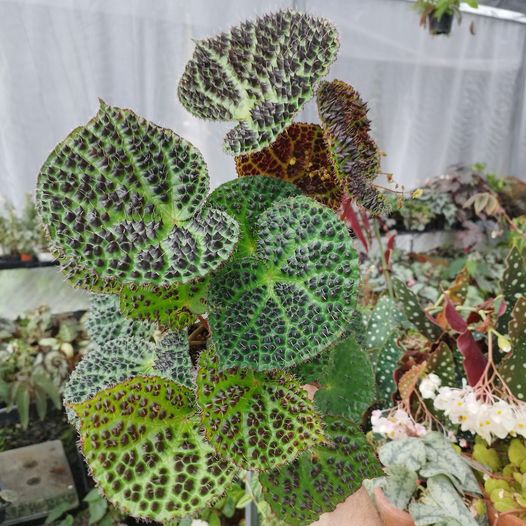Begonia melanobullata
Begonia melanobullata
Taxonomy
- Genus: Begonia - Species Cultivar: B. melanobullata - Author: C.-I Peng & C. W. Lin (Botanical Studies 2015, 56:9) - Publication Date: 2015 - Date of Origin: 2010 - Place: Cao Bang Province, Thach An District, N Vietnam - Habitat: Found on semi-shaded wet cliffs or steep limestone slopes in evergreen broad-leaved forests, at an elevation of 300–400 m.
Region
- Asia
Section
- Section: Coelocentrum
Genetics
- Chromosome Number: 2n = 30
Plant Type
Rhizomatous
Etymology
The specific name is derived from Latin words, melano (very dark) and bulla (bubble or blister), referring to the leaf surface.
References
- Ching-I Peng, Che-Wei Lin, Hsun-An Yang, Yoshiko Kono and Hieu Quang Nguyen. "Six new species of Begonia (Begoniaceae) from limestone areas in Northern Vietnam." Botanical Studies 2015, 56:9. - Hughes M. et al. "Asian Begonia 203, 2018."
Photos
description
Allied with B. ferox; TYPE: VIETNAM. Cao Bang Province, Thach An District, N 22°31’23”, E 106°20’41”. Living collection made on June 29, 2010; type specimens pressed from plants cultivated in the experimental greenhouse in Academia Sinica, Taiwan, 22 April 2014, Ching-I Peng 22609 (holotype: HAST; isotypes: E, HN) (Figures 6 and and77). Herbs, monoecious, perennial, rhizomatous. Rhizome stout, creeping, to 50 cm long,1–2 (−2.5) cm thick, internodes 1–2 cm long, villous near petiole insertion. Stipules yellowish to pale green, ovate-triangular, 1.4–2.5 cm long, 1–1.8 cm wide, strongly keeled, abaxially hairy along midrib, apex aristate, arista ca. 0.2 cm long. Petiole red to olive-green, terete, 8–21 cm long, 0.4–0.8 cm thick, densely white villous when young, turning brownish tomentose, sometimes subglabrous with age. Leaves alternate, blade asymmetric, widely ovate to widely elliptic, 13–21 cm long, 9–15 cm wide, broad side 6.5–12 cm wide, basal lobes cordate, 5–8.5 cm, apex caudate, base strongly oblique-cordate, margin repand, thick chartaceous, villous when juvenile, adaxially emerald green to yellowish green, surface densely bullate, bulla dark maroon, conical, 2–8 mm high, 3–8 mm across, tipped with a velutinous hair 6–10 mm long, abaxially pale green, reddish on veins and bullae, brownish tomentose on veins; venation palmate with 7–9 primary veins, midrib distinct, with 2–4 secondary veins on each side, tertiary veins reticulate or percurrent, minor veins reticulate. Inflorescences arising directly from rhizome, dichasial cymes branched 4–6 times; peduncle 15–38 cm long, tomentose; bracts at cyme base pale green, ovate, ca. 1 cm long, 0. 5 cm wide, boat-shaped, veins reddish, margin fimbriate, bracteoles on upper nodes similar but gradually smaller. Staminate flower: pedicel ca. 1.5 cm long, tepals 4, outer 2 broadly ovate, 6–9 mm long, 7–9 mm wide, abaxially greenish-reddish, sparsely setulose, adaxially yellowish-green, inner 2 greenish, elliptic, 5–7 mm long, 3–4 mm wide; androecium actinomorphic, spheroid, 2.5–3.5 mm across; stamens 65–80; anthers yellowish green to gold yellow, slightly compressed, obovate, 0.5–0.8 mm long, apex retuse to obtuse; filaments fused at base into a column ca. 1.5 mm long; Pistillate flower: pedicel ca. 1.5 cm long, tepals 3, outer 2 suborbicular or broadly ovate, abaxially reddish, adaxially yellowish-pinkish, 7–8 mm long, 7–8 mm wide, inner 1 yellowish-pinkish, elliptic, 4–6 mm long, 0.2–0.3 cm wide; ovary trigonous-ellipsoid, 8–10 mm long, 4 mm thick (wings excluded), reddish, sparsely dotted with sessile glands, 3-winged, wings unequal, reddish-green, lateral wings 2–3 mm wide, abaxial wing crescent-shaped, 8–10 mm long, 4–6 mm wide; styles 3, fused at base, yellow or greenish, ca. 3 mm long, stigma spirally twisted. Capsule trigonous-ellipsoid, 12–19 mm long, 5–8 mm thick (wings excluded), greenish or reddish when fresh; wings unequal, lateral wings 2–4 mm wide, abaxial wing crescent-shaped, 5–7 mm wide. Somatic chromosome number, 2n = 30. Distribution and ecology Endemic to Thach An District, Cao Bang Province, Vietnam (Figure 3), near the border between Vietnam and China. On semi-shaded wet cliffs or steep limestone slopes in evergreen broad-leaved forest, elevation at 300–400 m. Etymology The specific epithet refers to the color of the bullae on leaf surface. Notes Begonia melanobullata resembles B. ferox C.-I Peng & Yan Liu (Guangxi, China) and B. nahangensis Aver. & H. Q. Nguyen (Northern Vietnam) in having blackish bullae on leaf upper surface. However, Begonia melanobullata is sharply distinct in other aspects. The new species is similar to B. ferox, differing by the leaves widely ovate to widely elliptic (vs. ovate), peduncle 15–38 cm (vs. 5–13 cm) long, inflorescence branched 4–6 (vs. 3–4) times, staminate flower tepals greenish (vs. yellowish-reddish) and smaller anthers. Begonia melanobullata also resembles B. nahangensis, differing in the leaf apex acuminate (vs. obtuse), staminate flower greenish (vs. white to pinkish); tepals of pistillate flowers yellowish-pinkish (vs. light olive-green), suborbicular or broadly ovate (vs. broadly reniform). A comparison of salient features of the three species is shown in Table 3. Begonia melanobullata is known only from limestone areas in Cao Bang Province.

